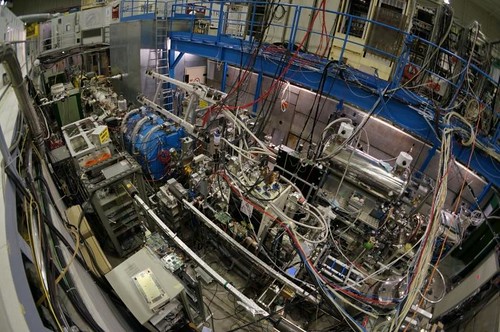
The ASACUSA experiment at CERN (Image: Yasunori Yamakazi )
The ASACUSA experiment at CERN has succeeded for the first time in producing a beam of antihydrogen atoms. In a paper published today in Nature Communications, the ASACUSA collaboration reports the unambiguous detection of 80 antihydrogen atoms 2.7 metres downstream of their production, where the perturbing influence of the magnetic fields used initially to produce the antiatoms is small. This result is a significant step towards precise hyperfine spectroscopy of antihydrogen atoms.
Primordial antimatter has so far never been observed in the universe, and its absence remains a major scientific enigma. Nevertheless, it is possible to produce significant amounts of antihydrogen in experiments at CERN by mixing antielectrons (positrons) and low energy antiprotons produced by the Antiproton Decelerator.
The spectra of hydrogen and antihydrogen are predicted to be identical, so any tiny difference between them would immediately open a window to new physics, and could help in solving the antimatter mystery. With its single proton accompanied by just one electron, hydrogen is the simplest existing atom, and one of the most precisely investigated and best understood systems in modern physics. Thus comparisons of hydrogen and antihydrogen atoms constitute one of the best ways to perform highly precise tests of matter/antimatter symmetry.
Matter and antimatter annihilate immediately when they meet, so aside from creating antihydrogen, one of the key challenges for physicists is to keep antiatoms away from ordinary matter. To do so, experiments take advantage of antihydrogen’s magnetic properties (which are similar to hydrogen’s) and use very strong non-uniform magnetic fields to trap antiatoms long enough to study them. However, the strong magnetic field gradients degrade the spectroscopic properties of the (anti)atoms. To allow for clean high-resolution spectroscopy, the ASACUSA collaboration developed an innovative set-up to transfer antihydrogen atoms to a region where they can be studied in flight, far from the strong magnetic field.
"Antihydrogen atoms having no charge, it was a big challenge to transport them from their trap. Our results are very promising for high-precision studies of antihydrogen atoms, particularly the hyperfine structure, one of the two best known spectroscopic properties of hydrogen. Its measurement in antihydrogen will allow the most sensitive test of matter/antimatter symmetry. We are looking forward to restarting this summer with an even more improved set-up," says Yasunori Yamazaki of RIKEN, Japan, a team leader of the ASACUSA collaboration. The next step for the ASACUSA experiment will be to optimize the intensity and kinetic energy of antihydrogen beams, and to understand better their quantum state.
Progress with antimatter experiments at CERN has been accelerating in recent years. In 2011, the ALPHA experiment announced trapping of antihydrogen atoms for 1000 seconds and reported observation of hyperfine transitions of trapped antiatoms in 2012. In 2013, the ATRAP experiment announced the first direct measurement of the antiproton’s magnetic moment with a fractional precision of 4.4 parts in a million.
Read the paper: "A source of antihydrogen for in-flight hyperfine spectroscopy" – Nature Communications
Source:http://home.web.cern.ch/about/updates/2014/01/antimatter-experiment-produces-first-beam-antihydrogen
以下是果壳网关于此文章的报道:
CERN首次产生出反物质束流
射出一束反物质束流,听起来像是科幻电影里的反派科学怪人才干得出来的事情。如今,这样的壮举已经被欧洲核子研究中心(CERN)的科学家实现了。他们制造反物质束流,可不是为了占领地球统制全人类,而是为了进一步探索新物理学,试图回答一个源自宇宙创生之初的大问题。
1月21日,CERN的ASACUSA实验团队在《自然通讯》(Nature Communications)上发文宣布,他们首次成功产生出了反氢原子束流。他们在论文中报告说,明确检测到了一束由80个反氢原子构成的、长达2.7米的反物质束流。取得这一成就的科学家说,这束反物质束流或许能够帮助他们破解更深的物理学谜题:为什么我们周围的宇宙中物质随处可见,却找不到些许反物质?
从理论上讲,在我们所知的宇宙创生的那一刻,宇宙大爆炸创造出来的物质和反物质,应该是等量的。但是,任何看过《星球大战》的人都会知道,物质和反物质一旦相遇,就会立即湮灭,除了一团能量,什么都不会剩下。然而,如今我们所处的宇宙完全被物质占据,反物质几乎踪迹全无。这到底是为什么呢?物理学家推测,这必定是因为物质和反物质之间,存在某种微妙的差异。
此前的粒子对撞实验已经为这种差异提供了少量线索,但物理学家还是希望能够真正去研究反物质原子,从而一举解决这一谜题。迄今为止,原始的反物质还从未在宇宙中被观测到过。不过,将CERN反质子减速器(Antiproton Decelerator)产生的低能反质子,与反电子(即正电子)混合,有可能在实验装置中产生出相当数量的反氢原子。
理论预言,反氢原子和氢原子的光谱应该是完全一样的。如果能够在两者之间找到任何细微差异,就将立即开启一扇通向新物理学的大门,也可能有助于解决反物质之谜。氢原子由单个质子和一个电子构成,是宇宙中存在的最简单原子,也是被研究得最精确、在现代物理学中被了解得最透彻的微观体系之一。因此,比对氢原子与反氢原子,也就成了高精度检验物质/反物质对称的最佳方式之一。
问题在于,以往产生出来的反物质原子很难存在足够长的时间,我们没有机会对它们进行精细的测量。物质和反物质只要相遇,就会立即湮灭。因此,除了创造出反氢原子以外,物理学家面临的另一项关键挑战就是,让反原子远离普通物质。
为了做到这一点,实验装置利用了反氢原子的磁属性(与氢原子类似),采用超强的非均匀磁场来约束反原子,将它们束缚足够长的时间加以研究。然而,强大的磁场(确切地说,是磁场的梯度)又会破坏反物质原子的光谱特性。为了获得纯净的高分辨光谱,ASACUSA团队开发了一套前所未有的装置,将反氢原子移到远离强磁场的区域,以便在它们飞行的途中细致地研究它们。
“反氢原子不带电荷,将它们移出约束阱是一项艰巨的挑战,”日本理化学研究所的山崎泰规(Yasunori Yamazaki)说,他也是ASACUSA团队的负责人之一。“对于反氢原子的高精度研究,特别是超精细结构研究来说,我们的结果给出了极好的前景。超精细结构是氢原子光谱中被了解得最为透彻的两个特性之一。测量反氢原子的这一特性,将为物质/反物质对称提供最为灵敏的检验。”
ASACUSA实验的下一步,将是优化反氢原子束流的强度和动能,进一步了解它们所处的量子态。山崎泰规透露,今年夏天他们将利用改进过的装置,重启这项实验。
PS:单个氢原子的质量约为1.67×10-27千克。根据爱因斯坦的质量能方程E = mc2,这束由80个反氢原子构成的束流如果全部湮灭成能量的话,将释放出2.4×10-8焦耳的能量——大概相当于10粒米以每秒1厘米的速度撞到你身上所释放的动能。所以,我们暂时还不必担心《星球大战》中能够毁天灭地的反物质炸弹会成为现实。




Big Jiang
我似乎已经找到留评论的法门了XD